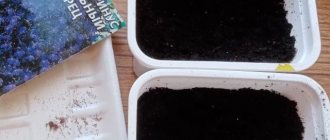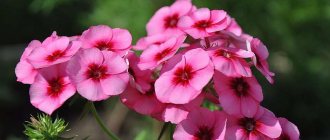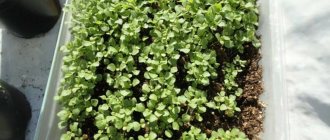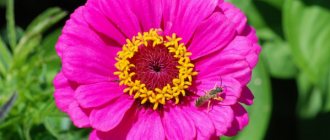What varieties of dichondra are grown from seeds?
Dichondra is an exotic climbing plant. Evergreen creeping stems look great as carpets in flowerbeds and as flower cascades on terraces and balconies.
There are about 10 varieties of dichondra. Flower growers have fallen in love with two species that are quite common in garden plots. These are the Silver Falls and Emerald Falls varieties.
Silver Falls is a plant with long three-meter stems with dense foliage and green-yellow flowers.
The shoots of the green waterfall are slightly longer.
Both varieties are densely covered with flowers that harmonize perfectly with the leaves.
What does dichondra look like, photo of a flower
Dichondra is a perennial plant native to tropical and subtropical forests.
The roots are often located very close to the surface of the earth (and often on the surface itself) and are well adapted to weather changes.
From a low bush, stems grow from 1 to 3 meters long, depending on the variety and place of growth.
Dichondra blooms throughout the summer with small flowers of different shades. Decorative round leaves can be painted in rich silver or green colors.
When to plant dichondra seedlings, in what month
In order to get healthy, full-fledged seedlings by spring, which will later grow into a gorgeous drooping or creeping bush, it is better to start sowing dichondra at the very beginning of winter.
Dichondra develops slowly, so it needs proper and complete care when grown at home, which will help the plant increase its vegetative mass by spring.
You can sow dichondra in 2022, starting from the very first days of January until the end of winter, choosing the planting day according to the lunar calendar.
Seasonal care
Regardless of whether dichondra grows indoors or outdoors, in the spring and summer it needs a lot of light, regular watering and feeding. Winter care will depend on the conditions in which the flower will be. If he grew up on the street, then he is moved indoors. It is advisable to provide such specimens with a cool winter.
Many gardeners prefer to store the plant in the basement. Before this, all shoots are cut to the ground, the bush is dug out along with a lump of earth. And in the spring it is planted in the ground again. Dichondra, which grows indoors in winter, requires regular spraying, moderate watering, and sufficient lighting. She does not need feeding.
Planting a flower for seedlings depending on the region
The climatic conditions of the regions differ from each other and make their own adjustments to the exact timing of sowing ornamental plants.
In the southern regions, spring comes earlier and allows gardeners to plant seedlings in open ground or in flowerpots already in mid-spring, when warm weather sets in. In these parts, seedlings can be sown immediately after the New Year.
In Central Russia, sowing dates move a little closer, so they are planted as usual in mid-January.
The harsh climate of the northern regions and the Urals does not allow planting seeds early, but you should not delay the start of cultivation either, otherwise the green mass will not gain the required volume. In these regions, flowers are usually planted in late January - early February.
Brief description of cultivation
- Bloom . Dichondra is cultivated as an ornamental foliage plant.
- Landing . Seeds for seedlings are sown in January or February, and young plants are planted in open soil from the last days of May to the second half of June.
- Illumination . Grows well in sunny areas, in diffused light, in shady areas and in shade. Varieties with silver foliage are more light-loving.
- Soil . Loams with good drainage and a pH of 6.6–8.0 are ideal for growing crops.
- Watering . Moisten the soil moderately but systematically, and do this in the evening to avoid burns on the leaf blades.
- Air humidity . During the hot, dry period, it is recommended to moisten the foliage in the evening.
- Fertilizer . During the growing season, fertilizing is carried out once every 15 days; for this purpose, complex mineral fertilizer with a high content of potassium and nitrogen is used.
- Trimming and pinching . To make the plant more lush, at the stage of formation of the fourth pair of leaf blades, its stems are pinched. Also, regularly trim the stems every 7 days as they grow.
- Reproduction . By seeds, layering and cuttings.
- Pests . Whiteflies, flea beetles, nematodes and aphids.
- Diseases . It is highly resistant to diseases.
When to plant dichondra seedlings in 2022 according to the lunar calendar
For a long time, flower growers and gardeners, before starting work, turn to the advice of the lunar calendar compiled by astrologers.
Favorable days for planting dichondra in 2022 according to the lunar calendar
In order for seedlings to become strong, they must form a healthy root system and grow green mass. The most suitable phase for sowing seeds for seedlings is the waxing moon phase.
The table below shows recommended planting dates.
| Month | When to plant |
| January | 4, 5, 6, 7, 8, 9, 10, 11, 12, 13, 14, 15 |
| February | 2, 3, 4, 5, 6, 7, 8, 9, 10, 11, 12, 13, 14, 15 |
| March | 3, 4, 5, 6, 7, 8, 9, 10, 11, 12, 13, 14, 15, 16, 17 |
When to plant dichondra seedlings in 2022 according to the lunar calendar is not worth it
According to the observations of astrologers, the following numbers will be unfavorable days for planting in 2022:
| Month | When not to sow |
| January | 1, 2, 3, 16, 17, 18, 19, 21, 22, 25, 26, 30, 31 |
| February | 1, 16 |
| March | 2, 18 |
Temperature
Dichondra seeds require warm soil to germinate. The best time for sowing is when the temperature is in the range of 21°C and the night temperature is in the range of 10°C.
Usually this is mid or late spring, or late summer - early autumn. When soil temperatures are too cold, germination and rooting of the plant will take much longer or may not occur at all. If possible, press the seeds lightly into the soil or cover with a very light layer of peat moss to retain moisture while the seeds germinate.
The seeds will germinate in 7-14 days. The first leaves will be long and narrow, and will not resemble dichondra at first.
What is needed for planting dichondra seedlings
Planting seeds is not difficult, but it does not tolerate neglect.
In order for the seedlings to turn out healthy, you need to take care of them already at the stage of selecting a variety and preparing the seeds for sowing. The quality of the future flower garden largely depends on these actions.
How to choose the right dichondra variety?
The choice of variety to grow depends on several nuances: what kind of plant you want to grow, the characteristics of the variety and the climatic conditions of the region where planting is planned.
It is also necessary to pay attention to weather conditions and weather forecasts. Nowadays, the weather quite often presents surprises to summer residents.
Planting dichondra seedlings at home, step by step photos
Once the seeds and soil are prepared, you can begin planting the seeds. Do this in several ways.
Sow in containers
This is the most common planting method.
The treated substrate is poured into a container or other container. Grooves with a depth of no more than 5 mm are made in it. The distance between them should be about 3 cm.
The seeds are carefully placed in the grooves, the distance between them should be 1.5-2 cm.
The crops are covered with a layer of soil.
Containers can be covered with glass or placed in a transparent plastic bag to create a greenhouse effect before germination.
How to sow in a “snail”
A very convenient method of planting, since planting seedlings after it is quite easy.
To form a snail, you can use polyurethane foam and toilet paper or a strip of fabric 10-12 cm wide. The earth is laid on this base in a layer of 1 cm.
The seeds are carefully placed on it at a distance of about 2 cm, and a thin layer of earth is placed on top.
The strip with the seeds is rolled into a snail and placed in a bowl. Water is poured on top. To obtain a greenhouse effect, the container with the snail is covered with a transparent bag and placed in a warm place until the sprouts appear.
RECOMMENDATION! To maintain moisture longer, pour a little water into the bottom of the container with the snail.
How to care for dichondra seedlings
Caring for the flower is simple, and even an inexperienced gardener can handle it.
Caring for dichondra immediately after sowing until emergence
After the seeds are sown, the containers with them are placed in a transparent bag or covered with glass and placed in a well-lit place.
Every day the container is ventilated for 20-30 minutes and watered as needed.
Care after entrances appear
After germination, care does not change much. The package is removed from the container and activities are carried out: watering, loosening, fertilizing and picking.
Weed control
The first priority for maintaining the health and density of dichondra plantings is weed control. Pre-emergence herbicides can also be used after dichondra is established. These types of herbicides will prevent any type of seed from germinating, so make sure your dichondra is well established and stop using herbicides about 8 weeks before reseeding your dichondra. You can also use post-emergent herbicides for grassy weeds such as mallard grass and crabgrass. Do NOT use herbicides (containing 2-4D) on dichondra, otherwise it will also die. Broadleaf weeds are difficult to control unless proper care is taken, which is the case with most groundcovers. Manual labor is usually required to control broadleaf weeds.
How to care for dichondra seedlings
With proper care, the first shoots will appear within 10-15 days and caring for them includes the following measures
Hardening
You should not immediately remove the shelter from the containers. The seedlings need to be gradually accustomed to fresh air. This is done gradually, ventilating the containers daily until their time without shelter reaches 10-12 hours.
Watering
It is very important to ensure that the soil does not dry out or become waterlogged. Water the dichondra with settled water at room temperature, spraying it with a spray bottle.
Top dressing
You can feed it already on the 10th day after germination. To do this, it is better to use special mineral fertilizers in liquid form based on humates. For example, potassium humate, Gumi-OMI, etc.
Possible diseases and pests
Aphids, whiteflies and garden flea beetles are the most common pests that plague the Dichondra plant; they can be easily neutralized through the use of mild insecticides, which is important for preserving the green cover.
It is recommended to remove weeds manually, avoiding damage to shoots and leaves during flowering; to improve growth, fertilize with weak nitrogen solutions; in case of strong growth, it is enough to reduce the frequency of watering.
Planting dichondra in open ground
Despite the fact that it is more common to grow dichondra from seeds at home, some varieties can be planted directly in open ground or hanging pots.
Which varieties are suitable for planting in open ground?
Among the few varieties that can be sown directly into a flowerbed:
- silver waterfall;
- emerald waterfall;
- emerald in silver.
When can dichondra be planted in open ground?
Sow seeds immediately in early spring. When the weather warms, they will sprout seedlings that will already be adapted to low temperatures.
ON A NOTE. This growing method is only suitable for regions with warm climates.
How to plant in open ground, step by step?
The site must be prepared.
It is cleared of weeds in advance and dug up. Fertilizers are applied if necessary.
Holes are made in the area so that the adult dichondra has enough space. You can place several seeds in the holes, then the dichondra will look thicker and more beautiful in the flowerbed.
The seeds are lightly covered with soil. You can also create a greenhouse effect by covering the area with film until sprouts appear.
Trimming
One of the many benefits of dichondra is that it requires less frequent mowing than lawn grass. However, it will look neater if mowed at least once every two weeks, and this will also help control weeds.
Set the mower to a height of 3 to 5 cm during the summer months. Low cutting at low temperatures promotes the formation of a dense, small-leaved cover.
Planting dichondra seedlings in open ground
You can start planting seedlings in a flowerbed only when the average daily temperature is between +13°C and +15°C.
How to choose a place to plant dichondra
When choosing a site, you need to pay attention to lighting. There should be enough of it, since this flower crop loves sunny areas.
The soil should be loamy and well drained. Winds and drafts are not desirable; it is better to protect the dichondra from them.
What can you plant dichondra next to?
Dichondra goes well with petunia, fuchsia and begonias. Its foliage creates a dense carpet, against which other flower crops look very beautiful.
How to prepare dichondra seedlings for planting in open ground?
We harden the seedlings for 2-3 weeks so that they do not experience severe stress after growing at home. This is done gradually, increasing the time spent outdoors, starting from 20 minutes.
How to prepare a place for planting dichondra outdoors
The area is dug up, cleared of debris and weeds, and then leveled. Since dichondra prefers to be cultivated on fertile soil, fertilizers should be applied. Ash or Nitroammofoska will do. Fertilizers are scattered over the surface if it will rain soon, or embedded in the soil.
How to plant flowers correctly, step by step
Planted according to the following scheme:
make holes in the prepared soil about 10-15 cm deep;
- seedlings, preferably with a clod of earth, are placed in a hole and covered with earth;
- compacted and watered.
ON A NOTE! If you water in advance, it is not necessary to water after planting.











